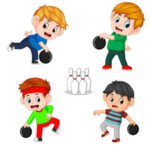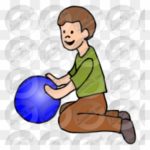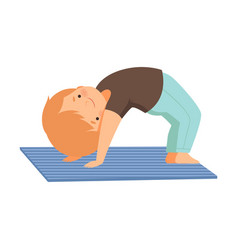
by Neetu | Jun 17, 2020 | Fitness Activity
Posture: Chakra-asana (The Wheel Pose)
Pronunciation: chu-krah-sa-na
Description:
Chakra, from the root cak (“to move”) means wheel and therefore this is the Wheel Posture.
The cakra-asana is also known as the urdhva-dhanurasana.
Urdhva means raised, elevated or upright and dhanur means bow. Both “wheel posture” and “raised bow posture” describe the appearance of this asana.
Performing Instructions
- Lie flat on the back in the shava-asana (corpse pose).
- While exhaling bend the knees and bring the feet as close to the buttocks as possible with the soles of the feet flat on the floor.
- Bend the arms at the elbows and place the palms of the hands flat on the floor directly under each shoulder with the fingers pointing toward the back.
- While inhaling slowly, begin to raise the head, back, and buttocks off the floor while arching the spine. Continue to press downward on the hands and feet while raising the hips and stomach as high as possible.
- Hold for the duration of the held inhaled breath. When you can’t hold the breath comfortable any longer, slowly exhale and return the back to the floor, slide the legs out straight returning to the shava-asana.
Comments:
The chakra-asana is more challenging than most other yoga postures. Don’t be discouraged if you are unable to accomplish it right away. Even attempting this posture without successful completion holds great benefits.
First and foremost is the strength and suppleness it restores to the spine. It strengthens the arms, shoulders, and upper back as well and stimulates the cardiovascular system. The chakra-asana has an overall tonic effect on the entire body.
As the natural suppleness of the spine is restored after a period of practice you can begin to perfect the form of this asana and thus experience greater benefits.
First, be certain that the arms are as straight as possible with very little to no bend in the elbows. When you can hold this comfortably, begin breathing through the nostrils while holding the posture and attempt to get a greater arch in the spine by bringing your hands closer to your feet and/or bringing your feet closer to your hands. Finally, you can extend the duration of the chakra-asana by doing several repetitions in sequence without resting in-between. As you return from the posture keep the hands behind the shoulders and the soles of the feet flat on the floor and as soon as the back returns to floor immediately raise it and enter the full posture again.
Duration/Repetitions:
The chakra-asana is either held for the duration of the inhaled breath or between one and three minutes while breathing gently through the nostrils. Repeat it two or three times.
The “Bridge” Variation:
Although this variation is much easier to perform than the full chakra-asana, it shares several of its benefits. In particular, it will help to stretch the spine and relieve tightness in the upper back and shoulder area.
To get the full benefit of the bridge variation continual effort should be applied to raising the back upward and creating the greatest possible arch with the spine.
While holding the bridge breath slowly through the nostrils. If there is no discomfort felt in the spine or shoulders then one should advance to the full variation of the chakra-asana as described above. Both variations strengthen the back and promote the flexibility of the spine. Tightness in the back and spine results from poor posture, stress, a sedentary lifestyle, and/or emotional disturbances. You should begin to feel the tightness being released after just a few repetitions.

by Neetu | Jun 16, 2020 | Fitness Activity
Posture: Bala-asana – The Child Pose
(Pronunciation: ba-lah-sa-na)
Description:
The Sanskrit word Bala means child.
Teaching Points: “As innumerable cups full of water, many reflections of the sun are seen, but the sun is the same; similarly individuals, like cups, are innumerable, but the spirit, like the sun, is one.”
Performing Instructions
- Sit on your knees with your feet together and buttocks resting on your heels. Separate your knees about the width of your hips. Place your hands on your thighs, palms down. (This is the vajra-asana or Thunderbolt Pose).
- Inhale deeply, then exhale as you bring your chest between your knees while swinging your arms forward.
- Rest your forehead on the floor, if possible, and then bring your arms around to your sides until the hands-on resting on either side of your feet, palms up.
- Breath gently through your nostrils as you hold the posture. Hold for about one to two minutes. Then return to an upright kneeling position with your back straight and your hands on your thighs.
- Repeat the posture at least one more time.
Comments:
The Bala-asana is one of the more relaxing Yoga postures and can easily be done by beginners. As part of your Yoga routine, it is best used as a counter-pose to any posture that stretches the spine backward (such as the naga-asana, the Chandra-asana, the chakra-asana, the ushtra-asana, etc.)
The Bala-asana gently stretches and relaxes the shoulders, neck, back muscles, and thighs.
Duration/Repetitions:
The Bala-asana can be held for as long as it is comfortable. Repeat at least twice if it is held for less than a minute.
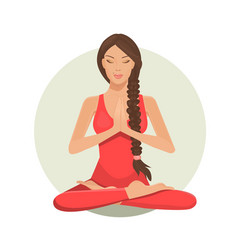
by Neetu | Jun 16, 2020 | Fitness Activity
Posture: Baddha-Kona-asana (The Restrained Angle Pose)
(Pronunciation: ba-dah-cone-ah-sa-na)
Description: The Sanskrit word Buddha means a bond, chain, caught or restrained. The word pada means foot, and Kona means corner or angle therefore this is the restrained-foot-angle posture.
Performing Instructions
- Sit on the floor with the legs together and extended straight out in front. Keep the back straight, shoulders level, and head straight. Place the hands, palms down, flat on top of the thighs then inhale deeply.
- Exhale and bend the knees drawing the feet toward the torso.
- Place the soles of the feet together, clasp the hands over the feet interlocking the fingers pulling the feet closer, and placing the heels against the perineum. The outer edge and small toe of each foot should touch the floor.
- Lower the knees to the floor and keep the back straight. Use the elbows to press down on the thighs if necessary to bring the calves and knees to the floor. Hold the posture breathing gently through the nostrils.
- Release the posture and sit with the legs extended out and hands on the thighs.
Comments:
Regular practice of the baddhakona-asana stretches the knees and stimulates circulation in the legs. It should be practiced frequently until one is comfortable sitting in the Padma-asana. The main areas of the body that are stimulated, besides the legs, are the stomach, pelvis, and lower back. It is said to keep the kidneys, prostate, and bladder healthy. The baddha-konasana is one of the few postures that can be practiced comfortably soon after eating.
Duration/Repetitions:
Hold the posture from thirty seconds to two minutes depending on comfort. Repeat two or three times.

by Neetu | Jun 16, 2020 | Fitness Activity
Ardha-matsyendra-asana (The Half Spinal Twist Pose)
Description: Ardha means half. Matsyendra is one of many Siddhas or masters who were accomplished Yogis mentioned in the medieval Yoga text the Hatha-Yoga-Pradipika. This posture is traditionally called the Spinal Twist because the spinal column is twisted gently.
Teaching Points: “Keeping the abdominal region at ease like the back, bending the left leg, place it on the right thigh; then place on this the elbow of the right hand, and place the face on the palm of the right hand, and fix the gaze between the eye-brows. This is called Matsyendra-posture.”
Performing Instructions
Sit in any comfortable cross-legged position.
- Straighten the legs out in front. Bend the right knee and bring the heel of the right foot close to the left hip.
- Inhale and bend the left knee upward and place the left foot flat on the floor to the right of the right leg with the ankle touching the right thigh.
- While turning the spine to the left straighten the right arm bringing it around to the outside of the left knee and grasp the left foot with the right hand.
- Turn your head as far as possible to the left and bend the left arm behind your back. Keep your spine, neck, and head aligned and continue to exert effort at turning to the left.
- Repeat the posture on the other side by reversing directions 2-6.
Comments:
The Half Spinal Twist is one of the best Yoga postures for cultivating flexibility and strength in the spine. It soothes stiff necks and upper back tension caused by stress, poor posture, or prolonged periods of sitting in one position.
The alternating compression and release of the abdominal region flush this area with blood and massages the internal organs. Muscles of the stomach and hips are also toned from repeated practice of the Half Spinal Twist.
Duration/Repetitions:
The posture can be held for as long as you are comfortable. (One repetition consists of performing the posture on each side. Two to three full repetitions should be done at each session.
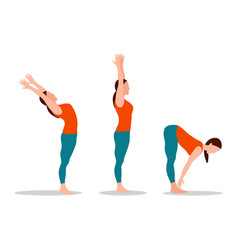
by Neetu | Jun 16, 2020 | Fitness Activity
Posture: Ardhachandra-asana – The Half-moon Pose
(Pronunciation: ard-ha-chun-drah-sa-na)
Description:
The Sanskrit word Ardha means “half,” and the word Chandra means “moon,” thus, this is the “half-moon” posture.
Performing Instructions
- Stand in the tada-asana (Stand with both feet touching from the heel to the big toe, keeping the back straight and the arms pressed slightly against the sides with palms facing inward.
- Bring the hands together at the chest with palms lightly pressed against each other (the Anjali-mudra).
- Inhale and raise the arms straight up keeping the palms pressed lightly together.
- Arch your body backwards keeping your arms alongside your neck and head, tilt the head backward and hold. Keep your knees straight while holding posture.
- Slowly return to the tada-asana.
Comments:
The ardha-chandra-asana is a basic stretching and balancing pose that benefits principly the lower back, abdomen and chest. It isequally suitable for use in your stretching routine as well as formal asana practice.
This pose is also one of the postures that are are sequenced in surya-namaskar (the Sun Salutation).
Duration/Repetitions:
Repeat ardha-chandra-asana two to three times.







